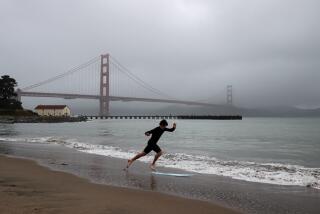Supreme Court hears arguments in L.A. storm water runoff case
WASHINGTON — The Supreme Court gave a skeptical hearing Tuesday to a Los Angeles lawyer who sought to absolve the county’s flood control district of responsibility for polluted storm water that flows into the Pacific Ocean.
“Doesn’t common sense suggest” the flood control district is responsible? asked Chief Justice John G. Roberts Jr. “The storm sewer system in Los Angeles hasn’t been shut down, right? You don’t question that there was an actual discharge [of pollutants]. What is it monitoring if not discharges … for which you’re responsible?”
FOR THE RECORD:
L.A. County storm runoff case -- A story in the Wednesday, Dec. 5, LateExtra section on a case before the U.S. Supreme Court regarding Los Angeles County’s liability for storm runoff into the Pacific Ocean incorrectly referred to the Natural Resources Defense Council as the National Resources Defense Council.
The justices tried to sort out a complicated regulatory dispute over the highly polluted water that flows down the Los Angeles and San Gabriel rivers in the days after a heavy rainstorm. They sounded split on how to rule, however.
They could free Los Angeles County from any liability on the grounds that its two monitoring stations in the rivers do not point to the source of the pollution. The county made just that argument. Or they could send the case back to a judge in California to hold further hearings aimed at pinpointing who is to blame for the polluted runoff.
During the argument, the justices focused on the words of the permit issued to the district. They gave no hint they would rule broadly on the problem of storm water runoff, which is national in scope.
The Clean Water Act requires cities of more than 100,000 people to limit to “the maximum extent practicable” the flow of pollutants into the “navigable waters of the United States.” This includes rivers, bays and the Great Lakes.
But a lawyer who represents municipal water agencies said most permits set only general requirements. “Storm water pollution is a fact of life. The permit usually says we will try to reduce it as best we can,” David Burchmore, a lawyer in Cleveland, said in a telephone interview.
In contrast, “California has the most elaborate permits, with hundreds of pages of detail,” he said. The Los Angeles permit set specific limits on certain pollutants, and the National Resources Defense Council and the environmental group Los Angeles Waterkeeper sued the county after its monitoring sites showed unacceptably high readings for fecal bacteria, arsenic, cyanide, mercury, copper and zinc.
The U.S. 9th Circuit Court of Appeals held the county liable last year on the grounds that water flowing past the monitoring site is an illegal “discharge” of pollution.
While agreeing with the flood control district that the flow of water in a river is not itself a discharge, lawyers for the NRDC said the court should not free Los Angeles from all liability.
“This pollution continues year after year,” said Aaron Colangelo, an NRDC lawyer. “The point of the Clean Water Act was to eliminate what everybody agrees is the biggest sources of water pollution in Southern California.”
Timothy Coates, representing the L.A. County Flood Control District, urged the court to reverse the 9th Circuit decision and end the case. “There is nothing further … really to argue about,” he said.
But Roberts and several other justices said the pollution readings suggested the county was at fault.
“What was the purpose of having the monitoring station if nothing can be done?” asked Justice Ruth Bader Ginsburg.
Coates said the monitoring showed there was a pollution problem, but it did not point to the source of it. He said a new permit, soon to take effect, would require monitoring at the many points where water flows into the rivers.
“So this was a regulatory void,” said Justice Sonia Sotomayor.
Despite the tone of the argument, the court’s conservatives said they were wary of sending the case back to the liberal-leaning 9th Circuit Court. Those judges could “adopt another fanciful interpretation of the statute, which is something I worry about,” said Justice Antonin Scalia.
More to Read
Sign up for Essential California
The most important California stories and recommendations in your inbox every morning.
You may occasionally receive promotional content from the Los Angeles Times.











